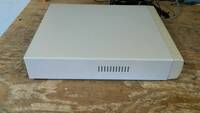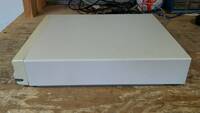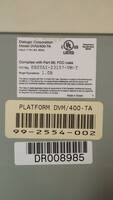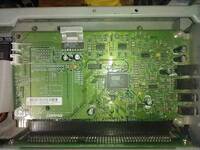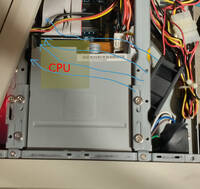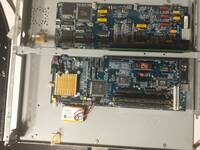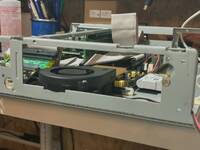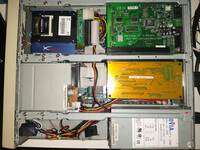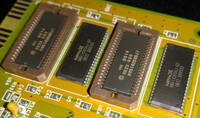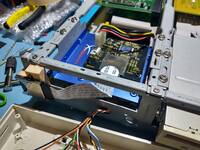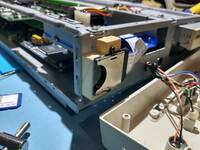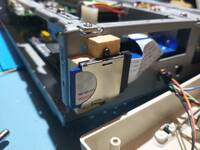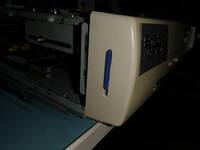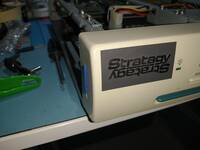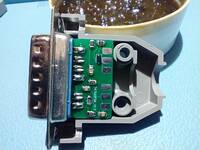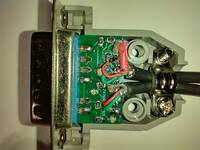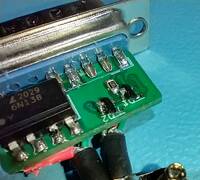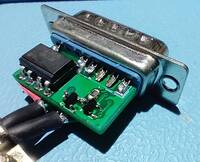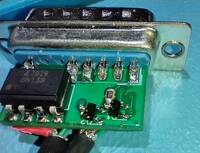victory (Dialogic Stratagy 486)
Summary
A voice mail system 486 with a custom motherboard built for dialogic. A voice card is integrated in the motherboard. Case is fairly compact with space for two 3.5" drives, and 3 ISA cards. I mounted it on the wall.
Notes
- Unstable at stock 66 MHz (freezes), had to up the bus to 40 MHz and run at 80 MHz.
- Sometimes partners with virtue since both can boot from the same SD card media (this machine being somewhat slow)
Hardware
| Make | Toshiba/Dialogic |
| Year | 1998 |
| Model | Stratagy 6D (DVM/400-TA) |
| Chassis | Stratagy 6D (DVM/400-TA) |
| Power Supply | Novia LC-150S 150W AT |
| Processor | STMicroelectronics ST486-DX2-66GS @80MHz |
| Memory | 32 MB HYM532414BM-60 |
| Ports | PS/2 Keyboard |
| DB-9 Serial | |
| Parallel | |
| 2x RJ-11 | |
| Graphics | SIIG MVGA-AVGA3 (Cirrus GD5429) 2MB |
| Storage | 4GB SD Card via SD-IDE adapter |
| 3.5" Floppy Drive | |
| Int. Peripherals | Dialogic DIALOG/4 Voice Card (onboard) |
| BTC 1853 ESS Audiodrive ES1868F | |
| 3Com EtherLink III 3C509B-TPO | |
| Ext. Peripherals | Roland MT-90S Midi Sound Source |
| Cherry MY-1800 PS/2 Keyboard | |
| Logitech C7 Serial Mouse | |
| Dimensions | |
| Length/Depth | 39 cm |
| Width | 33 cm |
| Height/Thickness | 7.5 cm |
| Weight | 5.77 kg (12 lbs 12 oz) |
Software
| Operating System | MS-DOS 6.22 |
| Windows for Workgroups 3.11 | |
| Windows 95 | |
| Windows NT 4 | |
| Unique applications |
Log
A 486-class machine
Purchased on ebay as Dialogic Stratagy DVM/400-TA. Tested to boot, specs were cyrix 486 dx2 66, 4MB ram, and no hard drive.
The board as it arrived:
Also some cool product photos/diagrams out of the Toshiba/Dialogic Stratagy Manual:
Parts
Started collecting parts:
- ES1869F sound card
- 3C509B network card
- 32MB ram in 2 72-pin simms
- msata ssd to ide board
- replacement 3.6v nimh battery (used a kastar pack for panasonic phones)
Assembly and freezing issues
Got machine assembled, but the mSATA drive wasn't detecting correctly. Went with a SD-IDE adapter for the time.
First doom session froze up. Have been working to reproduce and find a root cause. Memory tests generally pass, but could result in a freeze. Having a fan over the heatsink extends the runtime.
Took the board out and cleaned it more thoroughly. Found out the CPU is actually a ST micro branded 486 (still Cyrix' design). Replaced the two electrolytic capacitors near the CPU. All other caps are dipped tantalums or box tantalums (on the voice card side).
Was able to run 3 memtest passes without issue, then a long doom session. I removed the fan and ran for a little over an hour before having another freeze.
Overclocking helps stability
Changed the onboard voice card to default IRQ 9 from IRQ 5. I had one freeze when I bumped the SD module, but I may have shorted something. I also have a small suspicion the freeze may be disk I/O related, but I haven't been able to verify.
Still freezing. Tried setting CPU jumpers to exactly the silkscreen settings for 486 DX2. Didn't notice any change in performance or reported CPU speed. Still froze.
Tried overclocking. I set the bus speed to 40 MHz from 33MHz. So far I've been running Doom for 12 hours without a freeze.
Finalizing hardware
Build is mostly complete. Went with a 75mm blower for the CPU fan so it fits under the floppy. Two 8GB compact flash cards with a Syba adapter worked out well for storage. Might change out the PSU fan I swapped in for something even quieter, but I'm on to software setup.
Operating systems install.
I decided to go big on Microsoft with DOS 6, WFW 3.11, Win 95, and Win NT 4.
Installs were done without CD-ROM by extracting files to an extra partition on the main compact flash drive. I used this guide for ordering and adjusting boot files: How to Triple Boot to Windows NT, Windows 95, and MS-DOS.
Install order:
| Operating System | Install Path | Method |
| MS-DOS 6.22 | C:\DOS6 |
Floppy install |
| Windows NT 4 | D:\WINNT |
Copied files then ran WINNT.exe /b to install from disk. (source) |
| Windows 95 | C:\WIN95 |
Copied CD contents then ran setup.exe from DOS |
| Windows for Workgroups 3.11 | C:\WIN311 |
Extracted floppy images (7z x disk.img) then ran setup.exe from DOS, didn't let installer modify autoexec.bat or config.sys |
The guide mentions having to reinstall the NT bootloader, but for some reason my 95 install didn't affect it. Anyway here's the relevant knowledgebase article 104429 if you need it.
Trying a VRAM upgrade.
The SIIG MVGA-AVGA3 is a Cirrus CL-GD5429 chipset and comes with 1MB VRAM stock. The chips are marked NPN𝕏 (I think Nippon Steel Semiconductor) NN514260AJ-60. I got some slower (70ns) Hitachi HM514260DJ7 to fill the empty sockets.
This works fine, but the Cirrus chipset is more limited than I hoped. It can run 1024x768 in high color, but only at 87Hz interlaced, and that isn't acceptable to my modern Dell 2408WFP nor the old Dell E151FP LCD. So I've only really gained more colors in 800x600 and 640x480.
DOS sound issues
Trying out some old games and ran into a few troubles.
Supposedly the MPU-401 output can be configured to use the ES1868F's FM synthesis, but my card is jumper-less and ESSCFG.exe seems unable to modify it. I think this just means I'm reliant on DOS games supported the soundblaster/soundblaster pro synthesis.
The bigger wall I hit was with Heretic/Hexen. Both games support SoundBlaster output, but there's a repeated popping sound droning over all the sounds. I tried things like disabling write-through cache, disabling the cyrix cache completely, resetting bus speeed to stock (33 MHz), removing the network card, different sound IO settings, and a different ESS driver version recommended on Vogons. The sound seemed to coincide with disk activity, but I think that was just due to loading sounds.
Wolfenstein 3D also had some sound issues. Door sounds, dogs, and sometimes just multiple sounds at once resulted in distortion. It also had graphical glitches in the HUD. Interestingly both these issues were resolved by running it in Windows 3.1 (albeit there's a underscore cursor that blinks in a couple places).
Other sound apps that were ok:
- Doom 1/2
- System Shock (sshock.exe didn't play digital fx, but cdshock.exe play everything)
- Descent
- Simultaneous WAV and MIDI playback in Win 3.1
I have some other things to try:
- Swap out for my ES1869F (no gameport or IDE controller)
- Try my IDE-SD Card adapter in place of CF cards. Probably a long shot since disk IO doesn't interfere in other games/windows.
- Try running without a memory manager and other TSRs
- Maybe experiment with a different CPU. Also a long shot since, but 486 are reasonably cheap.
Narrowing down the sound problem
Tried out my alternative sound card (ES1869F) and a SD-IDE adapter for storage with good results. Narrowed the sound issues down to whenever I use compact flash cards. I tried rerouting the IDE cable and moving it around and it seems to have no influence on the issue.
Now that I know the CF cards are causing sound and graphics (only in wolf3d) issues it seems more like an interrupt/PIO/DMA issue. I tried an 8GB Apacer CF6, 8GB Apacer CF5, and a 2GB Transcend 133X. I don't have another compact flash adapter to test with at the moment.
Notable things are even with the CF card, running wolf3d in windows 3.1 doesn't produce issues. I tried watadiag on both the SD and CF card, and don't notice much difference in their capabilites so I don't think DOS is handling them that differently.
Other things to try:
- Find a dual SD to IDE adapter
- Try a different compact flash adapter. Maybe the 3.3V regulator or bus passives have issues.
SD Card Adapter with external access
A MIDI gameport adapter
I had gathered some bits and made a schematic to build a little adapter. My design is a mash up of the one ESS provides in this ES1869 Data Sheet (page 24) for the output, and this Teragon Audio circuit for the input. I opted for the 6N138 OptoIsolator, but I don't recall if there was an advantage.
My plan was to build the circuit directly on the D-Sub connector in one of these connector covers. However I ran into trouble with the surface mount diode and transistors I had chosen. The leads were just too small to build the circuit on itself. So I opted to throw together a PCB.
I built the first unit, but couldn't get the output working. I checked the sound card transmit pin. It seemed to have varying voltage when playing MIDI. Another check on the PCB design and I realized I had the transistor pinout incorrect. I was able to go back and flip the tiny transistors over, then use a component lead to bridge to the third pin.
If you want one like this I published the (probably working) revised version of my Kicad files on github.




